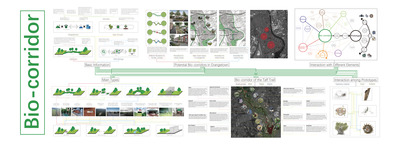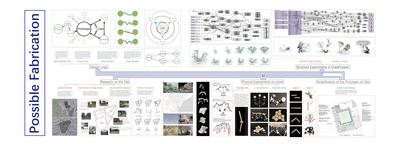Davidova, Marie  ORCID: https://orcid.org/0000-0002-1820-148X, Wang, Yuchen, Wang, Danjian, Feng, Yutao, Zhao, Yuan, Meng, Huicong and Wang, Meihui
2020.
Synergetic landscapes unit - gigamaps series.
[Online Exhibition].
National Institute of Design, Ahmedabad, India
, 9-18 October 2020. ORCID: https://orcid.org/0000-0002-1820-148X, Wang, Yuchen, Wang, Danjian, Feng, Yutao, Zhao, Yuan, Meng, Huicong and Wang, Meihui
2020.
Synergetic landscapes unit - gigamaps series.
[Online Exhibition].
National Institute of Design, Ahmedabad, India
, 9-18 October 2020.
|
![GIGA-FINAL-YUAN ZHAO.jpg [thumbnail of GIGA-FINAL-YUAN ZHAO.jpg]](https://orca.cardiff.ac.uk/136115/9.hassmallThumbnailVersion/GIGA-FINAL-YUAN%20ZHAO.jpg)  Preview |
Image (JPEG)
- Published Version
Download (33MB) | Preview |
![gigamap-01.jpg [thumbnail of gigamap-01.jpg]](https://orca.cardiff.ac.uk/136115/8.hassmallThumbnailVersion/gigamap-01.jpg)  Preview |
Image (JPEG)
- Published Version
Download (22MB) | Preview |
![personal minimap--YUANZHAO.jpg [thumbnail of personal minimap--YUANZHAO.jpg]](https://orca.cardiff.ac.uk/136115/10.hassmallThumbnailVersion/personal%20minimap--YUANZHAO.jpg)  Preview |
Image (JPEG)
- Published Version
Download (41MB) | Preview |
![concept.jpg [thumbnail of concept.jpg]](https://orca.cardiff.ac.uk/136115/5.hassmallThumbnailVersion/concept.jpg)  Preview |
Image (JPEG)
- Published Version
Download (13MB) | Preview |
![giga2.jpg [thumbnail of giga2.jpg]](https://orca.cardiff.ac.uk/136115/6.hassmallThumbnailVersion/giga2.jpg)  Preview |
Image (JPEG)
- Published Version
Download (14MB) | Preview |
![blockchain.jpg [thumbnail of blockchain.jpg]](https://orca.cardiff.ac.uk/136115/2.hassmallThumbnailVersion/blockchain.jpg)  Preview |
Image (JPEG)
- Published Version
Download (7MB) | Preview |
![Bio-corridor.jpg [thumbnail of Bio-corridor.jpg]](https://orca.cardiff.ac.uk/136115/3.hassmallThumbnailVersion/Bio-corridor.jpg)  Preview |
Image (JPEG)
- Published Version
Download (19MB) | Preview |
Preview |
PDF
- Published Version
Download (3MB) | Preview |
![Prototype.jpg [thumbnail of Prototype.jpg]](https://orca.cardiff.ac.uk/136115/7.hassmallThumbnailVersion/Prototype.jpg)  Preview |
Image (JPEG)
- Published Version
Download (16MB) | Preview |
Abstract
The gigamaps series is presenting work of students from Synergetic Landscapes unit of Master of Architectural Design at the Welsh School of Architecture. This collaborative design unit focuses on generating potentials for coperforming landscape of human and non-human, living and non-living, natural and artificial participants of Grangetown community, Cardiff, Wales, UK. The term community in this project is extended from what used to be understood in anthropocentric culture. In 21st century, i.e. rivers (such as Whanganui River) and others are reclaiming their legal personhood with social, cultural, economic and environmental interests (Argyrou & Hummels, 2019). This work in progress aims to integrate variety of living and non-living agents within the community in codesigning flourishing environment with and for All. The preoccupation with defining the legal person in anthropocentric terms highlights what is of value to an [Anthropocene] society. The fact that the environment in most legal systems does not have legal personhood status, but that corporations do, is indicative of the fact that contemporary western societies see the natural world as being for profit (Hutchison, 2014). The project aims for transition towards the era of Post-Anthropocene where living and non-living beings and systems coexist together in synergy.
| Item Type: | Show/Exhibition |
|---|---|
| Date Type: | Published Online |
| Status: | Published |
| Schools: | Schools > Architecture |
| Subjects: | G Geography. Anthropology. Recreation > G Geography (General) G Geography. Anthropology. Recreation > GB Physical geography G Geography. Anthropology. Recreation > GE Environmental Sciences G Geography. Anthropology. Recreation > GF Human ecology. Anthropogeography G Geography. Anthropology. Recreation > GN Anthropology G Geography. Anthropology. Recreation > GR Folklore G Geography. Anthropology. Recreation > GV Recreation Leisure H Social Sciences > H Social Sciences (General) H Social Sciences > HB Economic Theory H Social Sciences > HG Finance H Social Sciences > HJ Public Finance H Social Sciences > HM Sociology H Social Sciences > HN Social history and conditions. Social problems. Social reform H Social Sciences > HT Communities. Classes. Races L Education > L Education (General) N Fine Arts > NA Architecture N Fine Arts > NC Drawing Design Illustration N Fine Arts > NX Arts in general |
| Uncontrolled Keywords: | systems oriented design; systemic approach to architectural performance; systemic design; gigamapping; sod; sda; systemic design association; synergetic landscapes; circular economy; blockchain; community; codesign; master of architectural design; biocorridor |
| Date of First Compliant Deposit: | 5 November 2020 |
| Last Modified: | 09 Nov 2022 09:33 |
| URI: | https://orca.cardiff.ac.uk/id/eprint/136115 |
Actions (repository staff only)
 |
Edit Item |




 Download Statistics
Download Statistics Download Statistics
Download Statistics